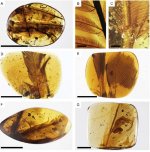albertonykus
Well-known member
Xing, L., P. Cockx, and R.C. McKellar (2020)
Disassociated feathers in Burmese amber shed new light on mid-Cretaceous dinosaurs and avifauna
Gondwana Research (advance online publication)
doi: 10.1016/j.gr.2019.12.017
https://www.sciencedirect.com/science/article/pii/S1342937X20300502
Even in the absence of associated skeletal material, isolated feathers in amber remain of high scientific interest. The remarkable preservation of these delicate structures in amber, implies a potential for significantly improving our knowledge of feather evolution and diversity. A large sample set of 150 Burmese amber specimens (Upper Cretaceous, ~99 Ma) containing feathers is herein described. Several structural types can be differentiated including flight feathers, contour feathers, semiplumes, and filoplumes. In some cases, peculiar pigmentation patterns and structural features can be documented. Additionally, different developmental stages have been captured in this assemblage with some examples of erupting feathers or neoptile plumage. Comparisons with previous studies including skeletal material described in amber, show that Enantiornithes and non avialan dinosaurs are most likely represented in the assemblage as well as unknown taxa.
Disassociated feathers in Burmese amber shed new light on mid-Cretaceous dinosaurs and avifauna
Gondwana Research (advance online publication)
doi: 10.1016/j.gr.2019.12.017
https://www.sciencedirect.com/science/article/pii/S1342937X20300502
Even in the absence of associated skeletal material, isolated feathers in amber remain of high scientific interest. The remarkable preservation of these delicate structures in amber, implies a potential for significantly improving our knowledge of feather evolution and diversity. A large sample set of 150 Burmese amber specimens (Upper Cretaceous, ~99 Ma) containing feathers is herein described. Several structural types can be differentiated including flight feathers, contour feathers, semiplumes, and filoplumes. In some cases, peculiar pigmentation patterns and structural features can be documented. Additionally, different developmental stages have been captured in this assemblage with some examples of erupting feathers or neoptile plumage. Comparisons with previous studies including skeletal material described in amber, show that Enantiornithes and non avialan dinosaurs are most likely represented in the assemblage as well as unknown taxa.





